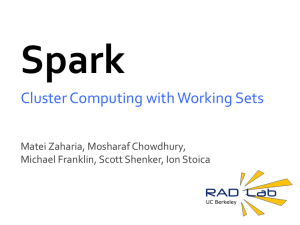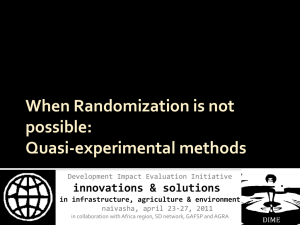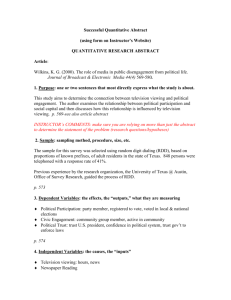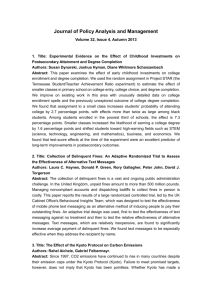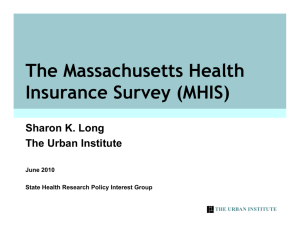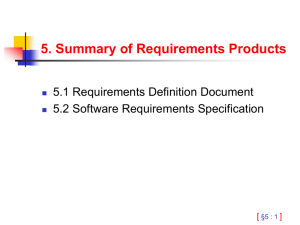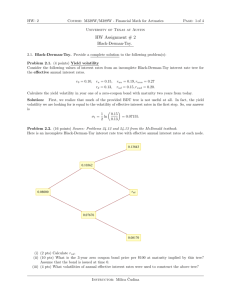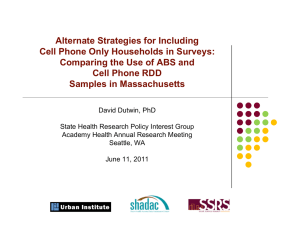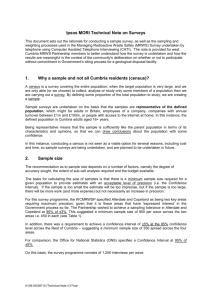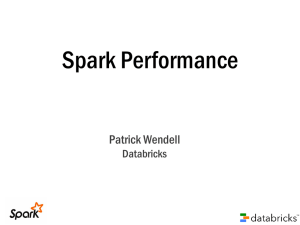Introducing… - Social Research Centre
advertisement
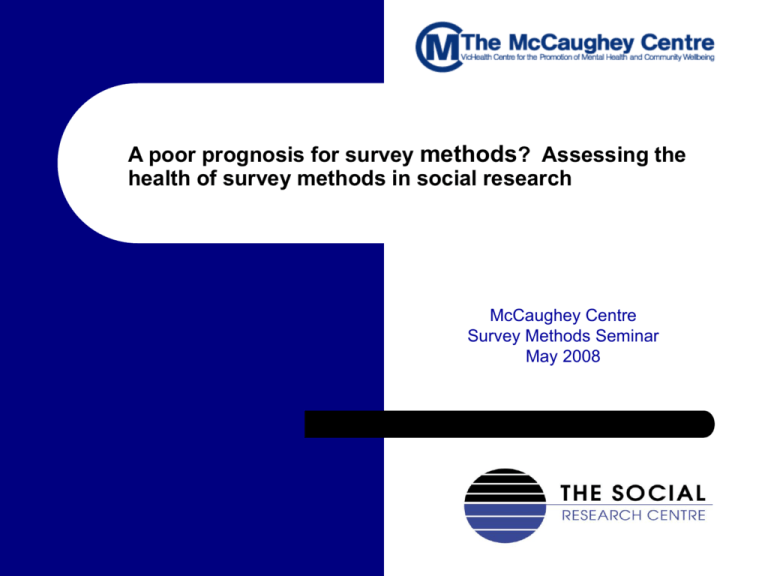
A poor prognosis for survey methods? Assessing the health of survey methods in social research McCaughey Centre Survey Methods Seminar May 2008 The Topic Survey methods have been a stalwart tool for social science research, however, traditional approaches to survey methods are becoming increasingly difficult to undertake. Letterboxes are overflowing with ‘junk’ mail, households are fatigued by unsolicited telephone calls and electronic home protection systems are turning homes into fortresses. With low response rates - what does this mean for ideals of ‘representativeness’ and what does ‘representativeness’ mean in contexts of increasing diversity within populations? For survey methods to adapt to these changing contexts for social science research and to continue to provide reliable and valid insights into people’s lives there is a need for innovative approaches. Sample frames Response Rates Methodological Innovations 2 Credentials About the Social Research Centre • Established in 2000 as a specialist provider of survey research services to government and academia • Operates as a social research supplier under the umbrella of the market and social research industry • 25 permanent staff • 180 telephone interviewers • 110 seat Call Centre • Our aim is to enhance knowledge and contribute to informed decision-making by undertaking high quality social and health research 3 About the Social Research Centre Services provided • large-scale survey design, conduct and management • longitudinal surveys • population health research • community attitudes research • campaign evaluation research • research amongst persons of culturally and linguistically diverse backgrounds • Programme evaluation and policy development research 4 About the Social Research Centre Research Areas social capital and community strength environmental attitudes and behaviours community well-being and connectedness welfare reform and income support population health monitoring poverty and social exclusion health promotion and social marketing parenting and families cancer research tobacco, drugs and alcohol employment and unemployment mental health education and training Racism skills shortages immigration and multiculturalism carers and persons with disabilities violence Indigenous research crime, justice and victimisation road safety 5 Random Digit Dialling (RDD) 6 RDD Background The rise of RDD and the demise of the Electronic White Pages (EWP) • Up until quite recently the Electronic White Pages was considered complete and accurate for most survey research purposes • The final version of the Desktop Marketing Systems (DtMS) Electronic White Pages (EWP) product was released in July 2004 and is still widely used by market research companies but is no longer used for high quality social research • Random Digit Dialing (RDD) methodologies are now the norm rather than the exception • One of the main barriers to the efficient use of RDD has been overcome by the development of automatic dialing technologies 7 EWP versus RDD • Methods of RDD generation Generation process involves Launched in 2003 • Undertaking a random selection of “seed” numbers from Government’s year plan for Queensland the 20045Electronic White Pages women Initiatives to address areas where women experience inequity, • Retaining the eight digit stem and deleting the last two under-representation and need digits • Randomly generating two numbers to append to the eight digit stem • Washing the resultant randomly generated ten digit numbers against business listings • Send those records for which we get a confirmed address a primary approach letter 8 EWP versus RDD Selected characteristics Selected demographic characteristics of persons with listed and unlisted phone numbers Characteristics Listed Unlisted VPHS 2005 (n=7,560) 5,449 2,111 Employed 50.7 60.3 Retired 33.2 15.4 University educated 22.9 28.3 Household income <$40k pa 49.7 46.6 Language spoken at home - English only 89.8 84.5 Dependent children in household 32.0 42.3 Divorced / separated 11.0 16.4 Resident in area less than one year 1.7 18.9 Renting 10.6 30.9 9 EWP versus RDD Selected characteristics Selected survey measures for persons with listed and unlisted phone numbers Characteristics Listed Unlisted VPHS 2005 (n=7,560) 5,449 2,111 Holds private health insurance 52.5 43.6 Daily smoker 14.6 22.0 Has an alcoholic drink every day 18.9 13.6 Sought professional help for mental health related illness 8.6 12.2 Could raise $2,000 within 2 days in an emergency 85.0 79.4 ICVS 2004 (n=6,000) 4,730 1,270 Victim of at least one crime in last 5 years 51.3 58.0 Victim of violent crime in last 5 years 17.5 24.4 Feels safe waiting for public transport after dark 60.7 55.9 All of the results are statistically significant at the 95% confidence interval. 10 RDD • Improved representation RDD samples can access different persons in terms of: Launched in 2003 • Age distribution Government’s 5 year plan for Queensland women • Demographic characteristics Initiatives to address areas where women experience inequity, under-representation and needor behavioural variables • Key usage, attitudinal • Inclusion of persons with unlisted numbers in the sample universe by using RDD techniques can achieve a more representative sample of the general population • BUT IN THE SPACE OF A DECADE THE REPRESENTATIVENESS OF SAMPLES OBTAINED FROM RDD FRAMES IS STARTING TO BE ERODED… 11 RDD Limitations of RDD frames • Little or no coverage of areas poorly represented in source listing e.g. emerging growth areas Launched in 2003 • The emergence of plan ‘mobile only’ households. Non Government’s 5 year for Queensland women coverage ofaddress households without a landline to be Initiatives to areas where women experience(used inequity, under-representation and need 1-2% but now probably around 13%)1,2 • Decreasing ability to obtain address matches and send out primary approach letters 1 12.8% of households in the US in 2006. National Health Interview, Public Opinion Quarterly, Vol. 71 2 One in four adults aged 18 to 24 years, Ibid. 12 Response Rates Are response rates declining? Generally, probably yes but not inevitably so Launched in 2003 In market research it has been predicted that … Government’s 5 year plan for Queensland women “Reach is increasing but co-operation is declining and nonInitiatives address areas wheretowomen experience inequity, rate contact to is increasing, leading a 3% decline in response under-representation and need per annum” (Bednall, 2000). Is the same true in social research …Possible yes but not inevitably so and certainly not to the same extent …. It depends on how hard you work… 13 Response Rates Selected findings Victorian Population Health 2005Survey 2006 Response Rate (%) 67.9 61.5 2007 69.3 Health system Feb-05 May-06 Aug-06 Nov-06 Feb-07 May-07 Aug-07 Nov-07 Government’s 5 year plan 59.3 59.2women 60.8 54.7 65.9 61.6 Response Rate (%) 67.9 61.5for Queensland Smoking and Health Survey 2004 Response Rate (%) 55.2 2005 54.9 Community Attitudes to Road Safety Response Rate (%) NTS Response Rate (%) National Drug Survey Response Rate (%) 2002 43.4 2003 43.4 2004 38 2006 43.3 2007 51 2003 68 2004 64 2004 52.3 2005 44.2 2005 73 2006 30.8 2006 66 2007 40.2 2007 42 14 Response Rates The current state of play Overall only marginally lower than they were several years ago or at least not substantially lower. Certainly no precipitous Launched in 2003 decline. This has been achieved by: • Government’s 5 year plan for Queensland women Extended call regimes • Longer fieldwork periods • Increased use of Primary Approach Letters • Increased reliance on bilingual interviewing • More sophisticated interviewer training • Leaving messages on answering machines • Increased reliance on survey sponsors to promote their surveys • Creating an internet presence for surveys • More calls to mobiles to obtain interviews with selected respondents 15 Population Research The future? • Access to the Integrated Public Number Data Base is needed to overcome these deficiencies • Mixed / multi modes data Government’s 5 yearof plan for collection Queensland women • On line access panels1 • Access to mobile phone directories • Advocacy is needed • Further research into advances in survey methodology is needed • Survey methods are certain to adapt to the changed environment as the alternative is sub standard population research 1. 2006 Census, 58% of households had an internet connection, 37% had broadband. 16 Population Research The future? A poor prognosis for survey methods? No, just continued innovation … 17 CATI Computer Assisted Telephone Interviewing CATI Quick Economical Good response rates ?? Direct data entry Computerised survey management system (SMS) Random Digit Dialling (RDD) Reaches silent numbers and recent connections ? More disconnected, non-household, fax __ Not completely random ?? 18 RDD Random Digit Dialing The proceedings from the first CATI Population Health Forum in 1998 record the following advantages of CATI and RDD: CATI quick economical good response rates direct data entry computerised survey management system (SMS) Random Digit Dialling (RDD) reaches silent numbers and recent connections more disconnected, non-household, fax not completely random 19
